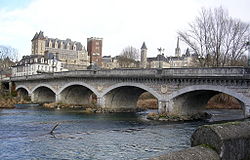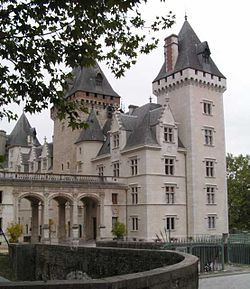- Château de Pau
-
The château seen from the banks of the Gave de Pau

The Château de Pau (English: Pau Castle) is a castle in the centre of Pau, the capital of Pyrénées-Atlantiques and Béarn. King Henry IV of France and Navarre was born here on December 13, 1553.
The château is located in the centre of Pau and dominates that quarter of the city. It was once used by Napoleon as a holiday home during his period of power. It has a small garden that was tended by Marie Antoinette when she spent much of the summer in the city.
The castle is classified as a Monument historique since 1840 by the French Ministry of Culture.[1] The castle nowadays contains a good collection of tapestries.
Contents
History
Origins
Pau Castle was founded in the Middle Ages. Work before any military, is a castle typically built on top of the hill overlooking the Gave bounded by ravine Hédas.
Since its construction, the castle takes on a symbolic importance: providing a stockade (poor, in Bearn) designate, by metonymy, the city itself. These piles, symbolizing loyalty and righteousness, are each asaxis mundiin a version of béarnaise. In the twelfth century {{}} Gaston IV of Béarn built three towers at the fortress. They are called Mazères Billère and Montauser.
Gaston Phoebus
The {{}} fourteenth century will see a figure emblematic of Bearn, who leaves his mark at the Chateau de Pau: Gaston III of Foix-Béarn, better known as the'Gaston Phoebus. This warlord, in a difficult position because, by their possessions, under the leadership of the enemy kingdoms of France and England, makes the Beam, "gift of God," a united and autonomous region. Fébus there built the tower of brick, high thirty-three meters, and it burns the inscription:feFebus me "(" Phoebus gave me, in Bearn).
At the Renaissance, installation of the court of Navarre in 1512, significantly alters the appearance of the castle. Fortress it was originally, it becomes a pleasure residence. Henri d'Albret resides with his wife Marguerite d'Angoulême, sister of François I, most known for Marguerite de Navarre, author of The' Heptaméron . They mark the place of their initials, present on the walls and ceilings, and that care was taken to maintain and reproduce over the subsequent restorations.
Henri IV
But their grand-son who gives the famous castle it is today: not by any architectural endeavor, nor even by his own will. The future Henri IV takes the trouble to be born December 13, 1553, and the story did the rest. The fame of the king, baby boy cradled in a turtle shell preserved by the Béarn through the vicissitudes of revolutions, gives the castle, which did not see him grow up or die, a particular taste, and the right to claim honors those who give birth supermen. But the real recognition of the king is posthumous, and we soon forgot the castle that he was born, except to gather Navarre and Bearn in the kingdom of France (Louis XIII y signed the treaty in 1620).
The Restoration
Louis-Philippe, which would combine the ideals of the Revolution and those of the monarchy, had the idea of restoring the castle of the man who reconciled Catholic and Protestant into a royal residence. Reside there, however.
The castle was mostly gilded prison in 1848 the emir Abd El-Kader, conquered by France Algeria. As might be that this castle should retain its character Henricians, placed there many objects neo-Renaissance and neo-Gothic and a magnificent collection of tapestries (16th - 19th century), to recall the halcyon days of good King. Louis-Philippe, in exile in England, could never stay at this place which was visited by Napoleon III. He is the Renaissance portal through which one enters and who bears the initials of the royal couple of Navarre, founder of the modern castle.
Today, the National Museum
Then the castle became a presidential residence in the Republic. He is currently a National Museum which houses the works preserved from the days of Henry IV and especially during the restoration made by Louis Philippe. The collections are increasing every year around the theme Henricians. It currently hosts over 100,000 visitors annually, making it the most visited heritage site of Pyrénées-Atlantiques.
Notes
See also
External links
Coordinates: 43°17′41″N 0°22′30″W / 43.29472°N 0.375°W
Categories:- Châteaux in France
- Pau, Pyrénées-Atlantiques
- Buildings and structures in Pyrénées-Atlantiques
- French castle stubs
Wikimedia Foundation. 2010.


